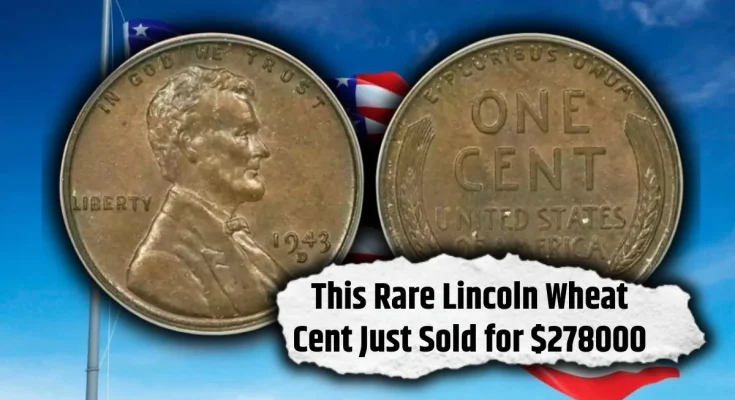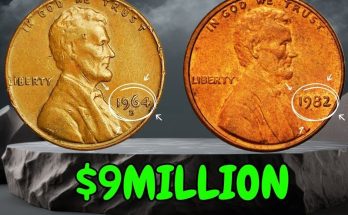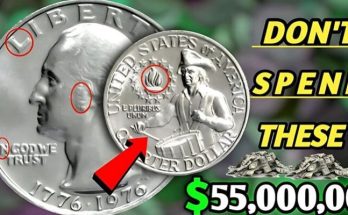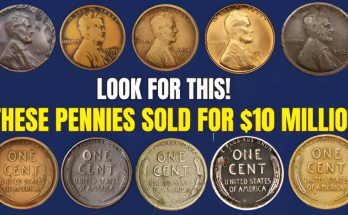Coin collecting, also known as numismatics, has long fascinated hobbyists, historians, and investors alike. It’s a realm where rarity meets history, and tiny discs of metal become time capsules worth small fortunes. Recently, a rare Lincoln Wheat Cent made headlines when it sold for a staggering $278,000 at auction, reigniting interest in one of America’s most iconic coin series. But what makes this seemingly ordinary penny so valuable? Let’s dive into the story behind the coin that has collectors buzzing.
The Lincoln Wheat Cent: A Brief Background
First minted in 1909, the Lincoln Wheat Cent was introduced to commemorate the 100th anniversary of President Abraham Lincoln’s birth. It replaced the Indian Head cent and became the first U.S. coin to feature a real person rather than symbolic representations of liberty. Designed by Victor David Brenner, the obverse of the coin shows a bust of Lincoln, while the reverse displays two wheat stalks – hence the name “Wheat Cent.”
Minted from 1909 to 1958, the Lincoln Wheat Cent was produced in billions, but not all coins were created equal. Variations in mint marks, years, and minting errors have turned some of these coins into incredibly rare collectibles.
The Star of the Show: 1943 Bronze Lincoln Cent
The cent that recently fetched $278,000 is none other than a 1943 Bronze Lincoln Cent – one of the most legendary error coins in U.S. numismatic history.
During World War II, the U.S. Mint sought to conserve copper for the war effort. As a result, cents struck in 1943 were supposed to be made from zinc-coated steel, giving them a shiny silver appearance. However, a small number of bronze planchets (coin blanks) left over from 1942 were accidentally used in the early minting process in 1943. The result? A few extremely rare 1943 Lincoln Cents made of bronze instead of steel.
Only about 10 to 20 of these coins are known to exist today. Their extreme rarity, coupled with historical significance and a fascinating backstory, makes them one of the Holy Grails of U.S. coin collecting.
Why This Coin Sold for So Much
The $278,000 price tag might seem outrageous for a penny, but several key factors drove the value sky-high:
-
Rarity: With possibly fewer than two dozen examples known, the 1943 bronze cent is one of the rarest Lincoln cents ever minted.
-
Historical Significance: The coin is a wartime error, tied directly to World War II – a period of massive historical importance.
-
Condition: The coin sold at auction was in near-mint condition, with minimal wear and brilliant luster, making it even more desirable.
-
Authentication: Certified by major grading services like PCGS (Professional Coin Grading Service), this particular cent was fully authenticated, increasing its trust and value.
-
Demand: The Lincoln cent series has a massive collector base, and many are eager to own a rare piece of history. Bidding wars are not uncommon when a coin of this caliber hits the market.
The Collector Craze
Lincoln cents have always had a special place in American culture. Millions of people began collecting them as children, filling blue coin folders with pennies found in change. That nostalgic connection, combined with the affordability of most Lincoln Wheat Cents, makes the series highly accessible.
However, at the high end of the spectrum, these coins can command serious cash. The sale of the $278,000 cent shows that the collector market is alive and well – and even getting more competitive. In an age of digital assets and NFTs, tangible history is still commanding premium prices.
Final Thought
The story of the $278,000 Lincoln Wheat Cent is a testament to the enduring allure of coin collecting. It reminds us that sometimes, everyday objects like a humble penny can hold immense value – not just in dollars, but in history and legacy. As collectors continue to seek out rare and unique pieces, coins like the 1943 bronze cent will remain prized trophies in the numismatic world.
So next time you’re sorting through your spare change, take a closer look. You might just be holding a fortune in the palm of your hand.
FAQs
Q1: How can I tell if I have a rare 1943 bronze Lincoln cent?
A: Start by checking the color – genuine 1943 steel cents are silver. If your 1943 penny looks like regular copper, it could be bronze. Use a magnet (steel cents will stick, bronze won’t) and consider having it authenticated by a reputable grading service like PCGS or NGC.
Q2: Why are 1943 bronze cents so rare?
A: The U.S. Mint accidentally used leftover bronze planchets from 1942 during early production in 1943. Only a small handful were made before the error was caught.
Q3: What’s the difference between a Wheat Cent and a regular Lincoln penny?
A: Wheat Cents were minted from 1909–1958 and have two wheat stalks on the reverse. Modern Lincoln cents (post-1959) feature the Lincoln Memorial or other designs.
Q4: Can I find a rare Lincoln cent in circulation today?
A: It’s very rare, but possible. Most valuable coins have been pulled from circulation, but checking change or old collections can still yield surprises.
Q5: Are all 1943 pennies valuable?
A: Not all. The common zinc-coated steel 1943 cents are worth about $0.10 to $3, depending on condition. Only the rare bronze ones are worth tens or hundreds of thousands.



